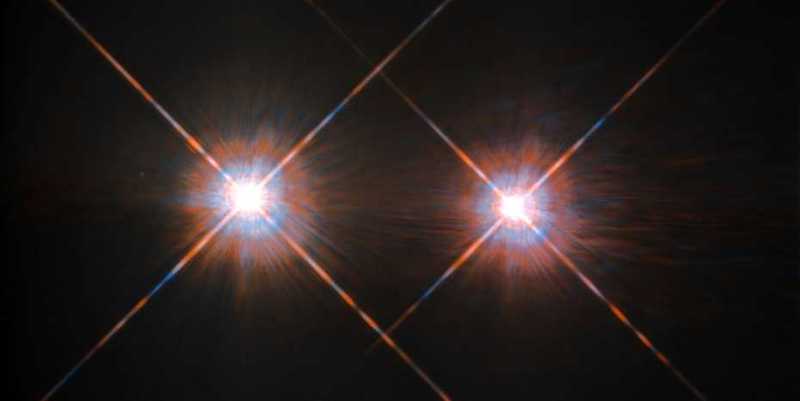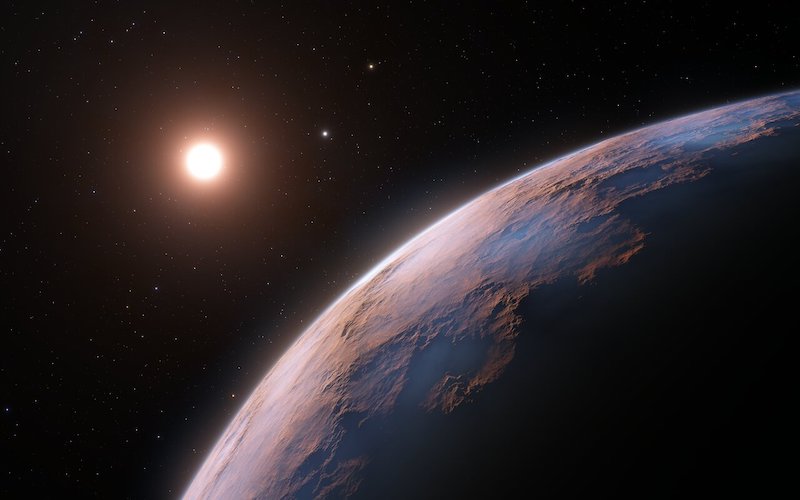
The closest stars to our sun are the three stars in the Alpha Centauri system, just over four light-years away. The nearest of the three stars – a red dwarf called Proxima – has two confirmed planets. But, as yet, no planets have been found for the two sunlike stars in the system, Alpha Centauri A and B. These two stars orbit one another closely (while Proxima orbits aroudn them, some distance away). On average, they lie about 23 astronomical units (AU) apart. That’s a little more than the distance between our sun and its 7th planet, Uranus. Astronomers have now made a leap in imagining a yet-to-be-discovered world within this nearby double star system. They used a new computer model to plug in what’s known about the two stars and extrapolated to find the characteristics of a possible world orbiting them. They’ve dubbed this hypothetical Earth-sized planet Alpha-Cen-Earth.
The Astrophysical Journal published this peer-reviewed study by researchers at ETH Zurich in Switzerland.

A hypothetical world in the Alpha Centauri system
Right now, such a planet is only hypothetical. But, based on what’s known about the two stars, Alpha Centauri A and B, astronomers can project what a rocky planet might look like and even how it formed.
ETH astrophysicist Haiyang Wang led the research team. These scientists calculated the composition of a hypothetical rocky planet in the habitable zone of Alpha Centauri A and B. This is the region where temperatures are suitable for liquid water to exist. It’s an interesting question, because the two stars – A and B – orbit one another relatively closely.
The scientists took what is known about the chemical compositions of Alpha Centauri A and B, and extrapolated the composition of a rocky planet in this system’s habitable zone. That makes sense because both stars – and any planets yet to be found – would have formed from the same primordial cloud of gas and dust. Expected elements in the hypothetical world Alpha-Cen-Earth included rock-forming elements (iron, magnesium and silicon) and volatiles (hydrogen, carbon and oxygen). From this, the researchers can not only estimate the mineralogy and inner composition of Alpha-Cen-Earth, but also its atmosphere.
Of course, the study doesn’t definitely say what a planet in this system would be like. But it is a reasonable model, based on the available information and data.

A potentially habitable planet?
Could there be any kind of life in the Alpha Centauri system? If there is a rocky planet in the Alpha Centauri system, it is likely to be similar to Earth, in terms of geochemistry, the researchers said. They said their model showed that this world would have a mantle enriched in carbon-bearing species such as graphite and diamond and dominated by silicates. This kind of mantle should be efficient at storing water, much like the mantle inside Earth.
As should be expected, Alpha-Cen-Earth wouldn’t be a perfect twin to our own Earth. It would possibly have a slightly larger iron core, lower geological activity and a lack of plate tectonics. But, the researchers calculated, that the planet’s early atmosphere would resemble the Earth’s early atmosphere. It should have abundant carbon dioxide, methane and water. Plate tectonics are thought to have played a large role in the habitability of Earth, but we don’t know yet how a lack of them on Alpha-Cen-Earth might affect its habitability.
Another factor is that the Alpha Centauri system is about 1.5 – 2 billion years older than our own solar system. Therefore, if any life ever did begin on a planet there, it would have had that much more time to evolve.

Volatile elements
This study is unique in that it focuses largely on volatiles (or volatile elements) on the hypothesized planet. Rocky planets tend to share the chemical compositions of their host stars. That, however, constitutes primarily the basic composition of refractory elements, the main elements found in rock and metal. But knowing the volatile elements, such as hydrogen, carbon and nitrogen is necessary for determining a planet’s potential habitability. These are elements that can easily vaporize.
This study is significant in that Wang developed the first model that accounts for both volatile and refractory elements. This allows for the study of a broader chemical connection between sun-like stars and rocky planets that orbit them.
Ideal time to search for an Alpha Centauri planet
As it happens, this is a great time to search for the hypothesized Alpha-Cen-Earth. Even though the Alpha Centauri system are the closest stars to the sun, the A and B stars are still far enough away that they usually look like one star to the unaided eye. Only in telescopes can they be distinguished as two separate stars. And it is more difficult to search for planets orbiting binary stars when they are close together.
But now, from 2022 to 2035, there is an opportunity to find planets in the Alpha system: The two stars will be far enough apart that it will be easier to detect planets orbiting them. Will astronomers find any planets there? And in particular, any like the hypothesized Alpha-Cen-Earth? We don’t know yet, but the next few years will give us the best chance to confirm the presence of planets (or not).
An earlier study from 2017 also suggested that smaller rocky planets were more likely in the Alpha Centauri system than larger ones. Time will tell if that study and the new computer modeling study are right!
In the meantime, astronomers have found 5,000 exoplanets (or exoplanet candidates) orbiting distant stars. Some – like those around Proxima in the Alpha Centauri system – are relatively nearby, cosmically speaking, while others are hundreds or thousands of light-years away. As we continue to explore these distant worlds, what will we find?

Bottom line: Are there any rocky planets resembling Earth in the Alpha Centauri star system? We don’t know yet, but a new study predicts what they may be like, and how potentially habitable they may be.
Source: A Model Earth-sized Planet in the Habitable Zone of Alpha Centauri A/B
The post An Alpha Centauri planet? Astronomers make a leap first appeared on EarthSky.
0 Commentaires